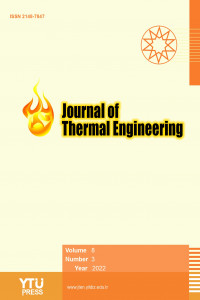Abstract
This paper aims to investigate the cubical fins and the thermal-hydraulic characteristics in a Printed Circuit Heat Exchanger (PCHE). The working fluid is considered a supercritical LNG. The outcomes show that the thermal-hydraulic performance is enhanced using the cubical fins comparing it to the straight channel. The maximum and minimum difference of N_u/E_u between the cubical fins channel and the straight channel were 71.7 % and 64.8 % respectively. It is noticed that the pressure drop and Heat Transfer coefficient are increasedsimultaneously with increasing the mass flux.Using Ansys Fluent 15.0, numerical optimization isperformed to examine and analyzethe influence of the sparser staggered arrangement. The computed results show that this type of arrangement improves the thermal-hydraulic efficiency of the cubical fins in a PCHE. A comparison between the straight fins arrangement and the staggered fins arrangement is reported.It has been noticed that the velocity of the LNG flow in the cubical fins channel is increased along the length of the PCHE,and decreased byincreasing the vertical separationL_V. The side effect of the vertical separation L_V on the PCHE’s efficiency was more evident than that of the staggered arrangementL_S. Finally, afeasibility study is performed to inspect the power consumption of the new design.
References
- The article references can be accessed from the .pdf file.
Abstract
References
- The article references can be accessed from the .pdf file.
Details
| Primary Language | English |
|---|---|
| Subjects | Mechanical Engineering |
| Journal Section | Articles |
| Authors | |
| Publication Date | May 16, 2022 |
| Submission Date | August 18, 2020 |
| Published in Issue | Year 2022 Volume: 8 Issue: 3 |
Cite
Cited By
Experimental study on heat transfer from rectangular fins in combined convection
Journal of Thermal Engineering
https://doi.org/10.18186/thermal.1401534
IMPORTANT NOTE: JOURNAL SUBMISSION LINK http://eds.yildiz.edu.tr/journal-of-thermal-engineering

